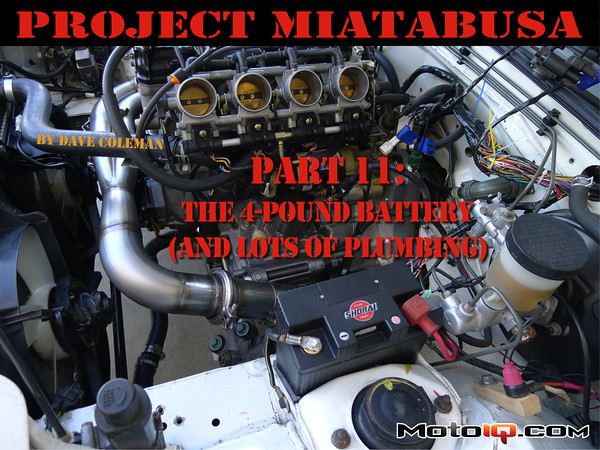
Project Miatabusa Part 11
Shorai Lithium Iron Battery (and Lots of Plumbing)
by Dave Coleman
Odds are pretty good this is the first Miata in history to have its battery relocated from the trunk to the engine bay. The reasons for this mod are pretty simple. The Hayabusa swap is taking so much weight off the nose of the car, the Miatabusa will actually be tail heavy! Suddenly, the simple ballast-shifting technique of battery relocation needs to go the other way.
But what battery to use? Lithium Ion batteries are the obvious choice, since their incredible energy density would make for an amazingly light battery, but there are two problems. First, Lithium Ion race batteries are comically expensive. Though prices are dropping, in the past year I’ve seen Lithium Ion race batteries that cost more than this whole Miata bodyshell. The second problem is their instability. Most of my experience with Lithium Ion batteries is from cheap chinese RC Lithium Polymer (LiPo) plane batteries, and these little beasts are notorious for their tendency to burst into flames if charged or discharged improperly.
Enter the Shorai Lithium Iron Phosphate (LiFePo4) batteries. Lithium Iron Phosphate is a relatively stable member of the Lithium Ion family. They’re stable in the face of heat, and they won’t ignite when shorted or overcharged. They’re slightly less energy dense than those Chinese LiPo batteries, but they’re still dramatically more dense than a lead-acid battery.

Shorai doesn’t technically make any automotive batteries, but they have a full line of motorcycle batteries. I can’t think of any reason why Motorcycle battery won’t work in a car, and certainly not one powered by a motorcycle engine and charged by a motorcycle alternator. Shorai’s direct replacement battery for the Hayabusa (theoretically all we would need to start a Hayabusa engine) weighs only 1.7 pounds!
LiFePo4 batteries have fundamentally different discharge characteristics from lead-acid which makes capacity comparisons a little tricky. Voltage drops less with load than lead acid batteries do, and they maintain high voltage through more of their discharge than lead-acid batteries (check out the chart on the right, a 12V Shorai battery is a dead battery), which means they can still start an engine deeper into their discharge than a Lead Acid battery.
Since the ability to start the engine is really what matters, Shorai concocted a “lead equivalent” amp-hour (PBeq AHr) rating that essentially compares the relative starter turning ability of their batteries to comparable lead-acid batteries. A Shorai battery with a 14 PBeq amp-hour rating doesn’t actually have 14 AHr of capacity, but it will start an engine just as well as a 14 amp-hour lead-acid battery can.
Let me just point out that batteries combine two of my least favorite subjects: chemistry and electricity, so I’m just going to take Shorai’s word for it on this rating.
Using their “lead equivalent” amp-hour rating, the 1.7-pound Hayabusa battery has a 14 Ah capacity. The 13-pound Odyssey PC680 sealed lead-acid battery I’ve used in Project Silvia and Project Frankenmiata is 13 Ah and has no problem starting an SR20 or a B6 engine, so this supports my theory that this 1.7 pound battery should be plenty for the Miatabusa. Most impressive, the Shorai Hayabusa battery costs about $150. That’s a remarkable price per pound saved if that battery can, indeed, start a car. Still, I didn’t get one…


The Shorai batteries only come in three sizes, but each one ships in a box full of adhesive-backed foam so you can make their sometimes-too-small battery fit perfectly in your motorcycle’s battery hole. This obviously would have solved my perfect-fit obsession, but in reality, my big battery choice had more to do with the extra cranking capacity. Extra capacity seems like a good idea for two reasons. First, I expect to be running close to the limit of the Hayabusa’s charging capacity, what with all the extra headlights and taillights of a car, so some reserve battery capacity seems smart. Also, there’s likely to be troubleshooting somewhere in this car’s future, and nothing makes troubleshooting more frustrating than a weak battery.
Shorai’s dizzying array of battery sizes and capacities can be really hard to sort through until you stumble onto this hidden page with all the specs and dimensions in one easy place.



